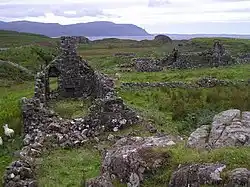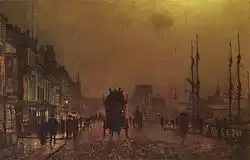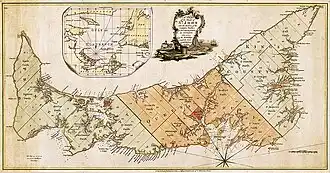
The Scottish Highland Clearances refers to a period of roughly a century in the history of Scotland running from around 1760 to 1860 during which a significant proportion of the population of the Scottish Highlands and Western Isles (Outer Hebrides) either left or were forcibly removed from their lands. The Clearances were undertaken as part of efforts to introduce more economically productive forms of agriculture such as mass sheep farming into northern and western Scotland. There was also a cultural element to them as the Scots of Lowland Scotland had looked down on the Gaelic culture of the Scots of the Highlands and Western Isles for centuries. The Clearances led to the forced and voluntary migration of hundreds of thousands of Scottish people between the mid-eighteenth and late nineteenth centuries. Many headed for Canada where they settled in vast numbers in places like Newfoundland and Prince Edward Island, while others headed for states like Georgia and Alabama in the United States.[1]
Research your ancestors on MyHeritage
The Scottish Highland Clearances chronology of eventsThe Scottish Highland Clearances chronology of events
Since late medieval times there was a growing economic and social divergence between Lowland and Highland Scotland. The Lowland Scots had adopted English as their native tongue and were aligning more closely with English cultural and political mores, while the Highland Scots of the north and those living in the Outer Hebrides or Western Isles clung to a more traditional Scottish way of life. They spoke Gaelic, had Gaelic surnames and followed many old customs. Their economic practices were also quite different. The enclosures movement, whereby large open fields were enclosed with ditches and walls and sectioned off into smaller private plots of land, had little impact here after the practice spread north from England into Lowland Scotland in the sixteenth and seventeenth centuries.[2]
The Highland Clearances were primarily undertaken to end the open field system and create more productive enclosed farms where more profitable arable farming and pastoral sheep farming would be practiced. In the process it was intended that the unreformed elements of Scottish Highland society would be broken up and made to resemble Lowland society. As such, they formed part of the wider Agricultural Revolution which was happening across Britain as major landowners tried to improve the economic performance of their lands.[3]
The Clearances took place in waves. The first Clearance began around 1760 and went on for several decades. It was more or less intense in various regions depending on who the major landholders were, as some were more committed to the process than others. During it many of the major nobles and gentry who owned large estates forced their tenants to abandon the open-field system and instead began enclosing their lands into smallholdings known as crofts. A common grazing space remained available, but essentially farmland was being reorganized into individual economic units as nascent capitalism was introduced into Scottish agricultural practices. It also led to far fewer people being employed as agricultural workers as modern ploughs and other more efficient methods were introduced. Consequently some people began to leave the land to head to the towns and coastal regions to work in fishing or other types of employment. And many others eventually left the Highlands altogether for the Scottish Lowlands or headed overseas to the United States, Canada and other regions of growing mass migration.[4]

Often those who left the land were coerced into doing so by aggressive landlords anxious to increase the profits generated from their lands. The Duchess of Sutherland, Elizabeth Leveson-Gower, and her husband, the Marquis of Stafford, George Leveson-Gower, were particularly bellicose. Between 1811 and 1821 they forced some 15,000 people off of their very large estates and brought in approximately 200,000 sheep as they sought to maximize wool production on their lands.[5]
A second wave of Clearances took place in the middle decades of the nineteenth century. This was brought about primarily by market developments. The prices of many commodities which were being produced in the Highlands such as wool from sheep fell dramatically once the European markets recovered after the end of the Napoleonic Wars in 1815. As this occurred some people voluntarily moved elsewhere, while there was also a much more aggressive practice of forced removals, with some landlords even paying their tenants to leave. Many used the cash provided to purchase tickets on passenger ships to North America. Finally, the potato famine that struck Europe in the second half of the 1840s compounded the issue and led to a final wave of migration away from the Highlands and the Western Isles in the 1850s.[6]
Extent of migration from the HighlandsExtent of migration from the Highlands

The Highland Clearances led to tens of thousands of Scottish inhabitants of the Highlands and Outer Hebrides migrating between 1760 and 1860. Many simply headed to the Scottish Lowlands and in particular the city of Glasgow, an urban center which lies close to the northern edge of the Lowlands. It had been a town of not much more than 10,000 souls in 1700 but expanded to over 70,000 by 1800 and 200,000 by 1850, fuelled by its emergence as a trade center, then as the epicenter of the Industrial Revolution in Scotland and also by inward migration from the Highland Clearances.[7]
Further afield there were tens of thousands of Scots who migrated to North America by the end of the eighteenth century. A great proportion of these were from the Scottish Highlands and Western Isles. They migrated in particularly large numbers to US states like Maryland, Virginia, North Carolina, South Carolina and Georgia and many of them, or their children, played a prominent part in the drive beyond the Appalachian Mountains to colonize Tennessee and Kentucky after the American Revolutionary War.[8] This was eclipsed though in nineteenth century by the migration of large numbers of Scots to British Canada, particularly Prince Edward Island, New Brunswick and Nova Scotia. 15,000 Scottish Highlanders had moved to Canada by 1815 and tens of thousands more arrived over the next half century.[9]
Demographic impact of the Highland ClearancesDemographic impact of the Highland Clearances

The Highland Clearances transformed the demographic landscape of Scotland. When a religious census was undertaken of Scotland by the Reverend Alexander Webster in the middle of the eighteenth century it was estimated that nearly half of the country’s population lived in the Highlands north of the River Tay and River Clyde. That figure had fallen to 40% by 1820 and then to 30% by the 1830s. Today the figure is below 20%. The administrative zone of the Highlands in modern Scotland has a population of just 235,000 out of a population of 5.5 million people in Scotland as a whole, despite constituting one-third of the country in terms of geographical size, though other parts of the north of Scotland have retained some population density, notably Aberdeenshire owing to the development of a North Sea oil and gas industry here. Nevertheless, the depopulation of the Highlands which took place between 1760 and 1860 has never been reversed.[10]
Abroad the demographic impact has been greatest in Canada, where nearly five million people, or roughly 14% of the population, claim Scottish ancestry of some kind. It is especially concentrated in some provinces. For instance, on Prince Edward Island today some 50,000 people are understood to have Scottish heritage, nearly 40% of the population. Similarly, an estimated eight million Americans are believed to have Scottish heritage, though many of these are descendants of the Scots-Irish, Scottish people who migrated to Ulster in Ireland in the seventeenth century, particularly so during the Scottish Great Famine of 1695-1697, and then left Ireland again for North America in the eighteenth century. Regardless, the influence of the migration associated with the Highland Clearances on North America has been substantial and many people in the US and Canada, as well as the Scottish Lowlands, will have an ancestor who left the Scottish Highlands in the century between 1760 and 1860 because of these economic and social changes.[11]
See alsoSee also
Explore more about the Scottish Highland ClearancesExplore more about the Scottish Highland Clearances
- Scotland, Births and Baptisms, 1564-1950 records collection on MyHeritage
- Scotland, Marriages, 1561-1910 records collection on MyHeritage
- Scottish Deaths, 1747-1868 records collection on MyHeritage
- 1861 Scotland Census records collection on MyHeritage
- Scotland, Gravestones and Memorials records collection on MyHeritage
- Scotland, Court of Session, Processes, Acts and Decrees, 1560-1930 records collection on MyHeritage
- Scotland, Commissary, Court Wills and Testaments records collection on MyHeritage
- Researching Your Scottish Ancestors at Legacy Family Tree Webinars
- Foundations of Scottish Genealogy at Legacy Family Tree Webinars
- Online Sources of Scottish Genealogy Research at Legacy Family Tree Webinars
- Finding Your Scottish Ancestors in Canada at Legacy Family Tree Webinars
- Do You Have the DNA of a Scottish Clan? at Legacy Family Tree Webinars
References
- ↑ https://www.historyextra.com/period/georgian/highland-clearances-scotland-guide-what-when-start-eviction-who/
- ↑ Keith M. Brown, ‘Early Modern Scottish History: A Survey’, in Scottish Historical Review, Vol. 92, No. 234 (April, 2013), pp. 5–24.
- ↑ Ian H. Adams and I. D. Whyte, ‘The Agricultural Revolution in Scotland: Contributions to the Debate’, in Area, Vol. 10, No. 3 (1978), pp. 198–205.
- ↑ T. M. Devine, ‘The Highland Clearances’, in Anne Digby and Charles Feinstein (eds.), New Directions in Economic and Social History (London, 1989), pp. 35–48.
- ↑ https://www.historic-uk.com/HistoryUK/HistoryofScotland/The-Highland-Clearances/
- ↑ Malcolm Gray, ‘The Highland Potato Famine of the 1840’s’, in The Economic History Review, New Series, Vol. 7, No. 3 (1955), pp. 357–368.
- ↑ Michael Meighan, Glasgow: A History (Stroud, 2013).
- ↑ Michael Fry, How the Scots Made America (New York, 2005).
- ↑ https://www.thecanadianencyclopedia.ca/en/article/scots
- ↑ T. M. Devine, ‘Highland Migration to Lowland Scotland, 1760–1860’, in The Scottish Historical Review, Vol. 62, No. 174, Part 2 (October, 1983), pp. 137–149.
- ↑ https://www.thecanadianencyclopedia.ca/en/article/scots

